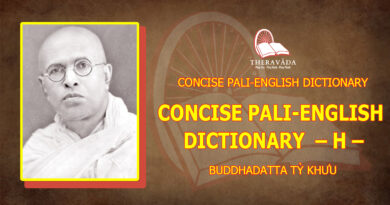Going For Refuge & Taking The Precepts – X. The Five Precepts – Bhikkhu Bodhi
X. THE FIVE PRECEPTS
1. The First Precept: Abstinence from Taking Life
The first of the five precepts reads in Pali, Panatipata veramani sikkhapadam samadiyami; in English, “I undertake the training rule to abstain from taking life.” Here the word pana, meaning that which breathes, denotes any living being that has breath and consciousness. It includes animals and insects as well as men, but does not include plants as they have only life but not breath or consciousness. The word “living being” is a conventional term, an expression of common usage, signifying in the strict philosophical sense the life faculty (jivitindriya). The word atipata means literally striking down, hence killing or destroying. Thus the precept enjoins abstinence (veramani) from the taking of life. Though the precept’s wording prohibits the killing of living beings, in terms of its underlying purpose it can also be understood to prohibit injuring, maiming, and torturing as well.
The Pali Buddhist commentaries formally define the act of taking life thus: “The taking of life is the volition of killing expressed through the doors of either body or speech, occasioning action which results in the cutting off of the life faculty in a living being, when there is a living being present and (the perpetrator of the act) perceives it as a living being”[6]
The first important point to note in this definition is that the act of taking life is defined as a volition (cetana). Volition is the mental factor responsible for action (kamma); it has the function of arousing the entire mental apparatus for the purpose of accomplishing a particular aim, in this case, the cutting off of the life faculty of a living being. The identification of the transgression with volition implies that the ultimate responsibility for the act of killing lies with the mind, since the volition that brings about the act is a mental factor. The body and speech function merely as doors for that volition, i.e., as channels through which the volition of taking life reaches expression. Killing is classified as a bodily deed since it generally occurs via the body, but what really performs the act of killing is the mind using the body as the instrument for actualizing its aim.
A second important point to note is that killing need not occur directly through the body. The volition to take life can also express itself through the door of speech. This means that the command to take life, given to others by way of words, writing, or gesture, is also considered a case of killing. One who issues such a command becomes responsible for the action as soon as it achieves its intention of depriving a being of life.
A complete act of killing constituting a full violation of the precept involves five factors: (1) a living being; (2) the perception of the living being as such; (3) the thought or volition of killing; (4) the appropriate effort; and (5) the actual death of the being as a result of the action. The second factor ensures that responsibility for killing is incurred only when the perpetrator of the act is aware that the object of his action is a living being. Thus if we step on an insect we do not see, the precept is not broken because the perception or awareness of a living being is lacking. The third factor ensures that the taking of life is intentional. Without the factor of volition there is no transgression, as when we kill a fly while intending simply to drive it away with our hand. The fourth factor holds that the action must be directed to the taking of life, the fifth that the being dies as a result of this action. If the life faculty is not cut off, a full violation of the precept is not incurred, though in harming or injuring living beings in any way its essential purpose will be violated.
The taking of life is distinguished into different types by way of its underlying motivation. One criterion for determining the motivation is the defilement principally responsible for the action. Acts of killing can originate from all three unwholesome roots — from greed, hatred, and delusion. As the immediate cause concomitant with the act of killing, hatred together with delusion functions as the root since the force which drives the act is the impulse to destroy the creature’s life, a form of hatred. Any of the three unwholesome roots, however, can serve as the impelling cause or decisive support (upanissaya paccaya) for the act, operating over some span of time. Though greed and hatred are always mutually exclusive at a single moment, the two can work together at different moments over an extended period to occasion the taking of life. Killing motivated primarily by greed is seen in such cases as killing in order to gain material benefits or high status for oneself, to eliminate threats to one’s comfort and security, or to obtain enjoyment as in hunting and fishing for sport. Killing motivated by hatred is evident in cases of vicious murder where the motive is strong aversion, cruelty, or jealousy. And killing motivated by delusion can be seen in the case of those who perform animal sacrifices in the belief that they are spiritually wholesome or who kill followers of other religions with the view that this is a religious duty.
Acts of taking life are differentiated by way of their degree of moral gravity. Not all cases of killing are equally blameworthy. All are unwholesome, a breach of the precept, but the Buddhist texts make a distinction in the moral weight attached to different kinds of killing.
The first distinction given is that between killing beings with moral qualities (guna) and killing beings without moral qualities. For all practical purposes the former are human beings, the latter animals, and it is held that to kill a fellow human being is a more serious matter ethically than to kill an animal. Then within each category further distinctions are drawn. In the case of animals the degree of moral gravity is said to be proportional to the animal, to kill a larger animal being more blameworthy than to kill a smaller one. Other factors relevant to determining moral weight are whether the animal has an owner or is ownerless, whether it is domestic or wild, and whether it has a gentle or a vicious temperament. The moral gravity would be greater in the former three alternatives, less in the latter three. In the killing of human beings the degree of moral blame depends on the personal qualities of the victim, to kill a person of superior spiritual stature or one’s personal benefactors being more blameworthy than to kill a less developed person or one unrelated to oneself. The three cases of killing selected as the most culpable are matricide, parricide, and the murder of an arahant, a fully purified saint.
Another factor determinative of moral weight is the motivation of the act. This leads to a distinction between premeditated murder and impulsive killing. The former is murder in cold blood, intended and planned in advance, driven either by strong greed or strong hatred. The latter is killing which is not planned in advance, as when one person kills another in a fit of rage or in self-defense. Generally, premeditated murder is regarded as a graver transgression than impulsive killing, and the motivation of hatred as more blameworthy than the motivation of greed. The presence of cruelty and the obtaining of sadistic pleasure from the act further increase its moral weight.
Other factors determinative of moral gravity are the force of the defilements accompanying the act and the amount of effort involved in its perpetration, but limitations of space prohibit a full discussion of their role.
2. The Second Precept: Abstinence from Taking What Is Not Given
The second precept reads: Adinnadana veramani sikkhapadam samadiyami, “I undertake the training rule to abstain from taking what is not given.” The word adinna, meaning literally “what is not given,” signifies the belongings of another person over which he exercises ownership legally and blamelessly (adandaraho anupavajjo). Thus no offense is committed if the article taken has no owner, e.g., if logs are taken to make a fire or stones are gathered to build a wall. Further, the other person has to have possession of the article taken legally and blamelessly; that is, he has to have the legal right over the article and also has to be blameless in his use of it. This latter phrase apparently becomes applicable in cases where a person gains legal possession of an article but does so in an improper way or uses it for unethical purposes. In such cases there might be legitimate grounds for depriving him of the item, as when the law requires someone who commits a misdemeanor to pay a fine or deprives a person of some weapon rightfully his which he is using for destructive purposes.
The act of taking what is not given is formally defined thus: “Taking what is not given is the volition with thievish intent arousing the activity of appropriating an article belonging to another legally and blamelessly in one who perceives it as belonging to another.”[7] As in the case of the first precept the transgression here consists ultimately in a volition. This volition can commit the act of theft by originating action through body or speech; thus a transgression is incurred either by taking something directly by oneself or else indirectly, by commanding someone else to appropriate the desired article. The fundamental purpose of the precept is to protect the property of individuals from unjustified confiscation by others. Its ethical effect is to encourage honesty and right livelihood.
According to the commentaries, for a complete breach of the precept to be committed five factors must be present: (1) an article belonging to another legally and blamelessly; (2) the perception of it as belonging to another; (3) the thought or intention of stealing; (4) the activity of taking the article; and (5) the actual appropriation of the article. By reason of the second factor there is no violation in taking another’s article if we mistakenly perceive it as our own, as when we might confuse identical-looking coats, umbrellas, etc. The third factor again provides a safeguard against accidental appropriation, while the fifth asserts that to fall into the class of a transgression the action must deprive the owner of his article. It is not necessary that he be aware that his possession is missing, only that it be removed from his sphere of control even if only momentarily.
Taking what is not given can be divided into many different kinds of violation. We might mention some of the most prominent. One is stealing, that is, taking what is not given, secretly, without the knowledge of the owner, as in housebreaking, a midnight bank theft, pickpocketing, etc. Another type is robbery, taking what is not given by force, either by snatching someone’s belongings away from him or by compelling him to hand them over by means of threats. A third type is fraudulence, laying false claims or telling lies in order to gain someone else’s possessions. Still another is deceit, using deceptive means to deprive someone of an article or to gain his money as when storekeepers use false weights and measures or when people produce counterfeit bills for use.
The violation of this precept need not amount to a major crime. The precept is subtle and offers many opportunities for its breach, some of them seemingly slight. For example, transgression will be incurred when employees take goods belonging to their employers, pocketing small items to which they have no right with the thought that the company will not miss them; when using another’s telephone to make long-distance calls without his consent, letting him cover the bill; in bringing articles into a country without declaring them to customs in order to avoid paying duty on them; in idling away time on the job for which one is being paid in the expectation that one has been working diligently; in making one’s employees work without giving them adequate compensation, etc.
By way of its underlying roots, the act of taking what is not given can proceed either from greed or hatred, both being coupled with delusion. Stealing by reason of greed is the obvious case, but the offense can also be driven by hatred. Hatred functions as the motive for stealing when one person deprives another of an article not so much because he wants it for himself as because he resents the other’s possession of it and wants to make him suffer through its loss.
The degree of blame attached to acts of stealing is held to be determined by two principal factors, the value of the article taken and the moral qualities of the owner. In stealing a very valuable article the degree of blame is obviously greater than in stealing an article of little worth. But where the value of the article is the same the blameworthiness of the action still varies relative to the individual against whom the offense is committed. As determined by this factor, stealing from a person of high virtuous qualities or a personal benefactor is a more serious transgression than stealing from a person of lesser qualities or from an unrelated person. This factor, in fact, can be even more important than the cash value of the object. Thus if someone steals an almsbowl from a meditative monk, who needs the bowl to collect his food, the moral weight of the act is heavier than that involved in cheating a racketeer out of several thousand dollars, owing to the character of the person affected by the deed. The motivation behind the action and the force of the defilements are also determinative of the degree of moral gravity, hatred being considered more culpable than greed.
3. The Third Precept: Abstinence from Misconduct in regard to Sense Pleasures
The third precept reads: Kamesu micchacara veramani sikkhapadam samadiyami, “I undertake the training rule to abstain from misconduct in regard to sense pleasures.” The word kama has the general meaning of sense pleasure or sensual desire, but the commentaries explain it as sexual relations (methunasamacara), an interpretation supported by the suttas. Micchacara means wrong modes of conduct. Thus the precept enjoins abstinence from improper or illicit sexual relations.
Misconduct is regard to sense pleasures is formally defined as “the volition with sexual intent occurring through the bodily door, causing transgression with an illicit partner”.[8] The primary question this definition elicits is: who is to qualify as an illicit partner? For men, the text lists twenty types of women who are illicit partners. These can be grouped into three categories: (1) a woman who is under the protection of elders or other authorities charged with her care, e.g., a girl being cared for by parents, by an older brother or sister, by other relatives, or by the family as a whole; (2) a woman who is prohibited by convention, that is, close relatives forbidden under family tradition, nuns and other women vowed to observe celibacy as a spiritual discipline, and those forbidden as partners under the law of the land; and (3) a woman who is married or engaged to another man, even one bound to another man only by a temporary agreement. In the case of women, for those who are married any man other than a husband is an illicit partner. For all women a man forbidden by tradition or under religious rules is prohibited as a partner. For both men and women any violent, forced, or coercive union, whether by physical compulsion or psychological pressure, can be regarded as a transgression of the precept even when the partner is not otherwise illicit. But a man or woman who is widowed or divorced can freely remarry according to choice.
The texts mention four factors which must be present for a breach of the precept to be incurred: (1) an illicit partner, as defined above; (2) the thought or volition of engaging in sexual union with that person; (3) the act of engaging in union; and (4) the acceptance of the union. This last factor is added for the purpose of excluding from violation those who are unwillingly forced into improper sexual relations.
The degree of moral gravity involved in the offense is determined by the force of the lust motivating the action and the qualities of the person against whom the transgression is committed. If the transgression involves someone of high spiritual qualities, the lust is strong, and force is used, the blame is heavier than when the partner has less developed qualities, the lust is weak, and no force is used. The most serious violations are incest and the rape of an arahant (or arahatess). The underlying root is always greed accompanied by delusion.
4. The Fourth Precept: Abstinence from False Speech
The fourth precept reads: Musavada veramani sikkhapadam samadiyami, “I undertake the training rule to abstain from false speech.” False speech is defined as “the wrong volition with intent to deceive, occurring through the door of either body or speech, arousing the bodily or verbal effort of deceiving another.”[9] The transgression must be understood as intentional. The precept is not violated merely by speaking what is false, but by speaking what is false with the intention of representing that as true; thus it is equivalent to lying or deceptive speech. The volition is said to arouse bodily or verbal action. The use of speech to deceive is obvious, but the body too can be used as an instrument of communication — as in writing, hand signals, and gestures — and thus can be used to deceive others.
Four factors enter into the offense of false speech: (1) an untrue state of affairs; (2) the intention of deceiving another; (3) the effort to express that, either verbally or bodily; and (4) the conveying of a false impression to another. Since intention is required, if one speaks falsely without aiming at deceiving another, as when one speaks what is false believing it to be true, there is no breach of the precept. Actual deception, however, is not needed for the precept to be broken. It is enough if the false impression is communicated to another. Even though he does not believe the false statement, if one expresses what is false to him and he understands what is being said, the transgression of speaking falsehood has been committed. The motivation for false speech can be any of the three unwholesome roots. These yield three principal kinds of falsehood: (1) false speech motivated by greed, intended to increase one’s gains or promote one’s status or that of those dear to oneself; (2) false speech motivated by hatred, intended to destroy the welfare of others or to bring them harm and suffering; and (3) false speech of a less serious kind, motivated principally by delusion in association with less noxious degrees of greed or hatred, intended neither to bring special benefits to oneself nor to harm others. Some examples would be lying for the sake of a joke, exaggerating an account to make it more interesting, speaking flattery to gratify others, etc.
The principal determinants of the gravity of the transgression are the recipient of the lie, the object of the lie and the motivation of the lie. The recipient is the person to whom the lie is told. The moral weight of the act is proportional to the character of this person, the greatest blame attaching to falsehoods spoken to one’s benefactors or to spiritually developed persons. The moral weight again varies according to the object of the lie, the person the lie affects, being proportional to his spiritual qualities and his relation to oneself in the same way as with the recipient. And thirdly, the gravity of the lie is contingent on its motivation, the most serious cases being those with malicious intent designed to destroy the welfare of others. The worst cases of false speech are lying in a way that defames the Buddha or an arahant, and making false claims to have reached a superior spiritual attainment in order to increase one’s own gains and status. In the case of a bhikkhu this latter offense can lead to expulsion from the Sangha.
5. The Fifth Precept: Abstinence from Intoxicating Drinks and Drugs
The fifth precept reads: Suramerayamajjapamadatthana veramani sikkhapadam samadiyami, “I undertake the training rule to abstain from fermented and distilled intoxicants which are the basis for heedlessness.” The word meraya means fermented liquors, sura liquors which have been distilled to increase their strength and flavor. The world majja, meaning an intoxicant, can be related to the rest of the passage either as qualified by surameraya or as additional to them. In the former case the whole phrase means fermented and distilled liquors which are intoxicants, in the latter it means fermented and distilled liquors and other intoxicants. If this second reading is adopted the precept would explicitly include intoxicating drugs used non-medicinally, such as the opiates, hemp, and psychedelics. But even on the first reading the precept implicitly proscribes these drugs by way of its guiding purpose, which is to prevent heedlessness caused by the taking of intoxicating substances.
The taking of intoxicants is defined as the volition leading to the bodily act of ingesting distilled or fermented intoxicants.[10] It can be committed only by one’s own person (not by command to others) and only occurs through the bodily door. For the precept to be violated four factors are required: (1) the intoxicant; (2) the intention of taking it; (3) the activity of ingesting it; and (4) the actual ingestion of the intoxicant. The motivating factor of the violation is greed coupled with delusion. No gradations of moral weight are given. In taking medicines containing alcohol or intoxicating drugs for medical reasons no breach of the precept is committed. There is also no violation in taking food containing a negligible amount of alcohol added as a flavoring.
This fifth precept differs from the preceding four in that the others directly involve a man’s relation to his fellow beings while this precept ostensibly deals solely with a person’s relation to himself — to his own body and mind. Thus whereas the first four precepts clearly belong to the moral sphere, a question may arise whether this precept is really ethical in character or merely hygienic. The answer is that it is ethical, for the reason that what a person does to his own body and mind can have a decisive effect on his relations to his fellow men. Taking intoxicants can influence the ways in which a man interacts with others, leading to the violation of all five precepts. Under the influence of intoxicants a man who might otherwise be restrained can lose self-control, become heedless, and engage in killing, stealing, adultery, and lying. Abstinence from intoxicants is prescribed on the grounds that it is essential to the self-protection of the individual and for establishing the well-being of family and society. The precept thus prevents the misfortunes that result from the use of intoxicants: loss of wealth, quarrels and crimes, bodily disease, loss of reputation, shameless conduct, negligence, and madness.
The precept, it must be stressed, does not prohibit merely intoxication but the very use of intoxicating substances. Though occasional indulgences may not be immediately harmful in isolation, the seductive and addictive properties of intoxicants are well known. The strongest safeguard against the lure is to avoid them altogether.







